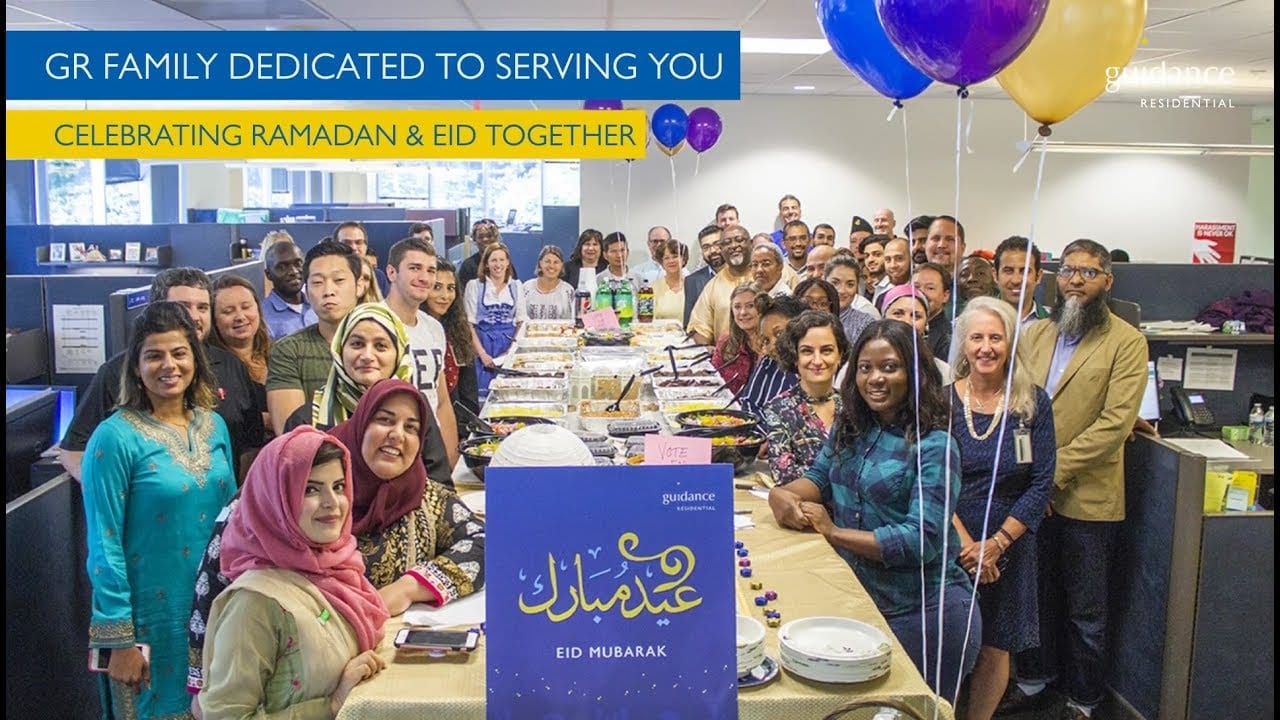Where Do Most Muslims Live in America?

The United States is a highly diverse country, particularly when it comes to religion. Islam is a growing religion in America, and the American Muslim population continues to grow too.
The most recent study by the Pew Research Center found that approximately 3.45 million Muslims lived in the United States in 2017, meaning that Muslims accounted for about 1.1% of the country’s total population. In addition, the Center forecasts that the Muslim population should reach 8.1 million by 2050.
Determining precisely how many Muslims live in America is a challenge, partially because the U.S. Census Bureau does not ask questions about religion. As a result, there is no official government count of the Muslim population in the country.
Largest Muslim Populations in the U.S.
The Muslim population is diverse, and the majority of the population are immigrants. The Pew Research Center reports that 58% of Muslim American adults ages 18 and over were foreign born. One in five U.S. Muslims was born in South Asia, 13% were born in the Asia-Pacific region, and 14% were born in the Middle East.
Additionally, 60% of U.S. Muslim adults are under the age of 40; 31% are college graduates, and 11% have a postgraduate degree. About half are married.
>> Related Read – 4 Prophetic Principles for Wealth Management and Personal Savings
Muslim Population by U.S. State
When looking at states with considerable Muslim populations, the lists differ depending on whether you are looking at total number of Muslims in the state or percent of the state’s total population.
New York is near the top of both lists, with the highest number of Muslims at three-quarters of a million and the second-highest percent of the state population. California, on the other hand, is the second state for number of Muslims but much lower on the list for percent of the state population.
Top 10 States by Percent
According to World Population Review, the U.S. state with the highest Muslim population concentration as a percent of the total site population is Illinois.
The top 10 states with the largest percent of Muslim residents rank as follows:
- Illinois – 3.7%
- New York – 3.6%
- New Jersey – 3.5%
- Maryland – 3.1%
- Michigan – 2.4%
- Virginia – 2%
- Massachusetts – 1.9%
- Arizona – 1.5%
- California – 1.3%
- North Carolina – 1.3%
Muslim Population by U.S. City
According to Wikipedia, the U.S. metropolitan region with the highest Muslim population concentration is New York City. The top five cities with the largest estimated Muslim population concentrations include:
- New York City, NY
- Houston, TX
- Philadelphia, PA
- Dearborn, MI
- Los Angeles, CA
- Paterson, NJ
Why Does It Matter?
America is a melting pot in which people of all backgrounds and religious groups thrive side by side, and most Americans are friendly and welcoming regardless of religious identification. That said, people of all groups typically enjoy finding at least a few others like them, and many American Muslims prefer to live in areas with a thriving Muslim community.
A large population of Muslims can mean access to amenities like mosques, shopping, Islamic schools, and neighbors with similar backgrounds.
Being part of a Muslim community can serve as a way for you to connect with neighbors, building important connections and relationships. Establishing those connections can help you to more easily settle into your new location, particularly if you’re making a large move and are unfamiliar with the new neighborhood.
Mosques
Having a mosque nearby is not only convenient but can help you quickly feel like you belong to your new neighborhood.
According to Islam, there are many benefits of praying at a mosque. The reward for praying in a congregation is 27 times more than the reward of praying alone. Praying in a mosque can also offer an escape from the chaos of daily life, and it can serve as a valuable opportunity to focus solely on your faith. It can provide you with a sense of safety, as well as a sense of being an important member of the Muslim community.
It is important to note that every U.S. state and city should be Muslim-friendly due to every U.S. citizen being afforded the right to religious freedom.
Community
With more than half of adult Muslim Americans born outside the country, finding a city with a considerable Muslim population can mean cultural and ethnic familiarity as well.
Many of the cities with the largest Muslim populations will vary by ethnicity, with a higher percent of residents originating from various Muslim majority countries. Some cities, for example, are home to more Arab Americans, others are more heavily South Asian, while others are home to more native-born African American Muslims.
Immigrants and even second generation Muslims often find a welcome familiarity by finding at least a few others who speak the same language and cook the same foods.
Shopping
Cooking familiar foods can mean the need to access specific ingredients. Communities with higher Muslim populations are more likely to support grocery stores that sell those ingredients needed for favorite ethnic dishes.
Islamic Schools
Some American Muslims prefer to educate their children at private schools that teach principles of their faith along with core subjects. Again, these are more likely to be available in cities where more Muslims live.
>> Related Read – Can Muslims Get a Mortgage?
Additional Considerations: Choosing the Right Neighborhood for You
When buying a house, it’s important to not only focus on finding the right house, but also finding the right neighborhood. A neighborhood can shape your homeownership experience for the better or the worse.
Starting with a location known for having an established Muslim population can be a good start, but to find the best location, you’ll need to do some research and think about the factors that are most important to you. The following tips on how to choose a neighborhood can help ensure that you select the location that’s truly the right fit for you and your family.
Schools
If you have children or plan to have children in the future, it’s also important to consider the school district when choosing a new neighborhood. To get a sense of the quality of the school district, you can use online school rating systems, like those offered by the U.S. News & World Report.
Buying a home in a good school district offers several advantages. A good school district will often provide your child with a better education than a lower-quality district will. Choosing a great district can be a long-term investment in the quality of your child’s education, and in their future too.
But buying a home in a good school district can also help to stabilize your home’s value. Homes in school districts with higher ratings tend to have and maintain higher values than homes in districts with lower ratings. You may be able to get a higher price for your home when you’re eventually ready to sell, thanks to the appeal of the school district’s quality.
>> Related Read – How Do I Know If A Neighborhood Is Safe? 4 Ways to Check
If you have school-age children, this is also a good time to research the school transportation options available. Look into factors like bus routes, the proximity of bus stops, and how long your child’s bus ride might be. Spending time researching these factors can help to confirm that the neighborhood is a good fit for your whole family.
Commerce
Consider the industries that are local to the neighborhood. Easy access to grocery stores, the pharmacy, department stores, restaurants, and entertainment venues can enhance your quality of life and your enjoyment of the neighborhood. Think about how the distance that you would have to travel to these amenities differs from the distance that you travel in your current location.
It’s also important to look for a neighborhood that allows you to access employment. Do you plan to remain with your current employer, and if so, how will living in the new neighborhood impact your commute? If you plan to seek out a new job or change your career, look into the availability of relevant employers in the new neighborhood.
>> Related Read – Best Mortgage Company for the Self-Employed in 2023
Spend some time thinking about the maximum commute that you are willing to make. Remember that your commute time affects more than your schedule. If you will be driving to work, a longer commute means greater wear and tear on your vehicle, and it can also result in an increase in your car insurance rates.
Alternatively, you may want to research the availability of public transportation in the neighborhood. Consider factors like the types of transportation available, the closest stops, and the cost of the transportation. Look into whether routes will take you to your common destinations, and think about how long the trip would be.
Multigenerational Living
In some cases, the right home and neighborhood may need to accommodate multigenerational living. There are many benefits to this model, including valuable family support and a return to the teachings of the Islamic faith. Multigenerational living allows you to give back to your parents and loved ones, and it can be a rewarding arrangement.
If you’re thinking of pursuing multigenerational living, either now or in the future, then consider the type of arrangement that would work well for you. Some families live together under one roof, while others live in the same neighborhood.
Look for a neighborhood that will support the needs of every generation in your family. That means finding a balance between elements like a quality school district, the availability of plenty of employment opportunities, access to quality healthcare facilities, and more.
Affordability
A neighborhood’s rent and home prices will also help to determine whether the location is a good fit. Home prices can fluctuate depending on the neighborhood, and they tend to be higher in in-demand areas, like neighborhoods with good schools or with other appealing amenities like vacation attractions or good healthcare facilities.
As you explore different neighborhoods, it’s helpful to research the average home costs. You can accomplish this by browsing listings on MLS.com. Pay attention not only to the property’s selling price but also to the tax rates.
If you are looking to rent, research not only the typical rental costs but also what is traditionally included in the area. In addition to rent, you may be responsible for all utilities, as well as the first and last month’s rent. Look into the common rental terms and try to get a sense of whether rentals are readily available, or if they’re more difficult to come by in the neighborhood.
>> Related Read – Is It Better to Rent or Buy Right Now?
Don’t forget to also consider the overall cost of living in an area. You’ll find that the cost of living can vary significantly depending on the neighborhood and location that you’re considering. The cost of living, or the amount of money that you will need to spend to cover basic living expenses, is affected by the cost of food, housing, utilities, transportation, health, and miscellaneous items.
The cost of living fluctuates, with events like the pandemic and fuel costs affecting everything from utility costs and the price of food. But the cost of living can also be location-dependent. For example, it costs far more to live in New York City than in Virginia’s small towns like Culpeper or Orange.
If you’re planning to move to a new location, it’s important to assess the cost of living to determine whether the move is affordable, particularly if you plan to continue on with your current employment. If you’re moving to a location with a higher cost of living, you may need to find a position that pays you significantly more so that you can afford to live in the new area. This can add stress to a move, and you don’t want to find yourself financially overwhelmed soon after you’ve moved.
>> Related Read – Renting vs. Buying a House: Advantages & Disadvantages
It’s helpful to start by determining your current cost of living, so you can better gauge how the move will affect your finances. To start, add up your monthly expenses, including fixed expenses like a mortgage, and variable expenses, like gas or groceries. These monthly, essential expenses are your monthly cost of living.
Understanding how to assess the cost of living gets a little more challenging when you’re trying to determine the cost for a location that you don’t yet live in. In this instance, using a cost of living calculator can help.
>> Tip – Use These Calculator Tools to Estimate How Much Home You Can Afford to Purchase and Determine Whether It’s Best for You to Rent or Buy.
The Bottom Line
Buying a home can be a highly rewarding and exciting experience, and it can change your entire family’s lives. As you move forward with your homebuying plans, you will need to consider the mortgage option that’s right for you.
Guidance Residential can help Muslim homebuyers with an Islamic mortgage as well as with finding a local real estate agent (thanks to Guidance Home Services).
Get Pre-Qualified Online in Fewer Than 10 Minutes, and We’ll Connect You with a Knowledgeable and Reliable Real Estate Agent to Ensure Your Homebuying Experience Goes Smoothly.
Originally published in May 2023, updated January 2024.




